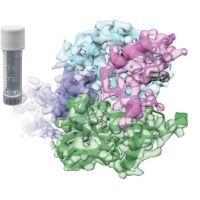Specification
| Organism | Homo sapiens (Human) |
| Expression Host | Mammalian cell |
| Tag Info | C-terminal hFc-tagged |
| Purity | Greater than 93% as determined by SDS-PAGE. |
| Uniprot ID | P52803 |
| Uniprot Entry Name | |
| Gene Names | EFNA5 |
| Alternative Names | AL-1 (EPH-related receptor tyrosine kinase ligand 7) (LERK-7) |
| Expression Region | Full Length of Mature Protein (21-203aa) |
| Molecular Weight | 50.1 kDa |
| Endotoxin | Less than 1.0 EU/ug as determined by LAL method. |
| Sequence | QDPGSKAVADRYAVYWNSSNPRFQRGDYHIDVCINDYLDVFCPHYEDSVPEDKTERYVLYMVNFDGYSACDHTSKGFKRWECNRPHSPNGPLKFSEKFQLFTPFSLGFEFRPGREYFYISSAIPDNGRRSCLKLKVFVRPTNSCMKTIGVHDRVFDVNDKVENSLEPADDTVHESAEPSRGEN |
| Product Form | Lyophilized powder (Lyophilized from a 0.2 μm filtered PBS, 6% Trehalose, pH 7.4) |
| Reconstitution | We recommend that this vial be briefly centrifuged prior to opening to bring the contents to the bottom. Please reconstitute protein in deionized sterile water to a concentration of 0.1-1.0 mg/mL.We recommend to add 5-50% of glycerol (final concentration) and aliquot for long-term storage at -20℃/-80℃. Our default final concentration of glycerol is 50%. Customers could use it as reference. |
Background
| Relevance | Cell surface GPI-bound ligand for Eph receptors, a family of receptor tyrosine kinases which are crucial for migration, repulsion and adhesion during neuronal, vascular and epithelial development. Binds promiscuously Eph receptors residing on adjacent cells, leading to contact-dependent bidirectional signaling into neighboring cells. The signaling pathway downstream of the receptor is referred to as forward signaling while the signaling pathway downstream of the ephrin ligand is referred to as reverse signaling. Induces compartmentalized signaling within a caveolae-like membrane microdomain when bound to the extracellular domain of its cognate receptor. This signaling event requires the activity of the Fyn tyrosine kinase. Activates the EPHA3 receptor to regulate cell-cell adhesion and cytoskeletal organization. With the receptor EPHA2 may regulate lens fiber cells shape and interactions and be important for lens transparency maintenance. May function actively to stimulate axon fasciculation. The interaction of EFNA5 with EPHA5 also mediates communication between pancreatic islet cells to regulate glucose-stimulated insulin secretion. Cognate/functional ligand for EPHA7, their interaction regulates brain development modulating cell-cell adhesion and repulsion. |
| Function | |
| Involvement in disease | |
| Subcellular Location | |
| Protein Families | |
| Tissue Specificity | |
| Pathway |
QC Data
| Note | Please contact us for QC Data |
| Product Image (Reference Only) |  |

